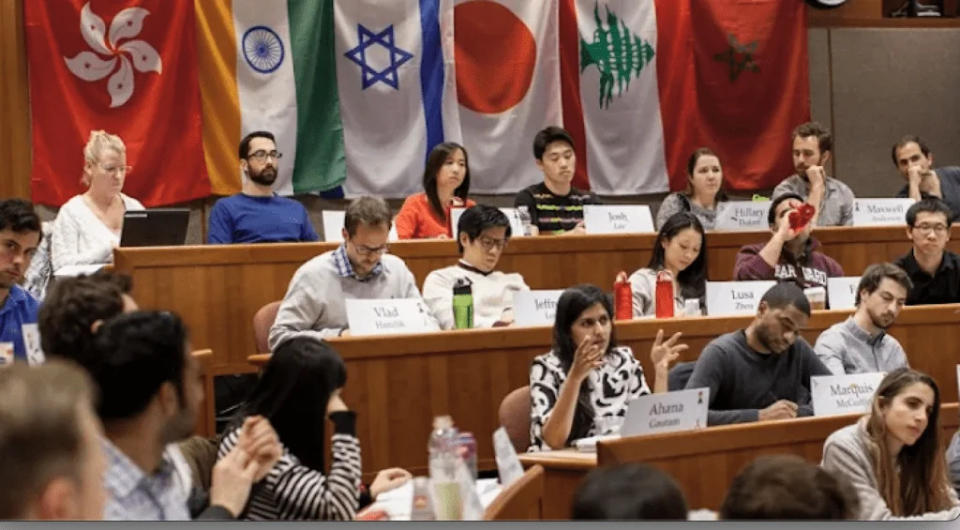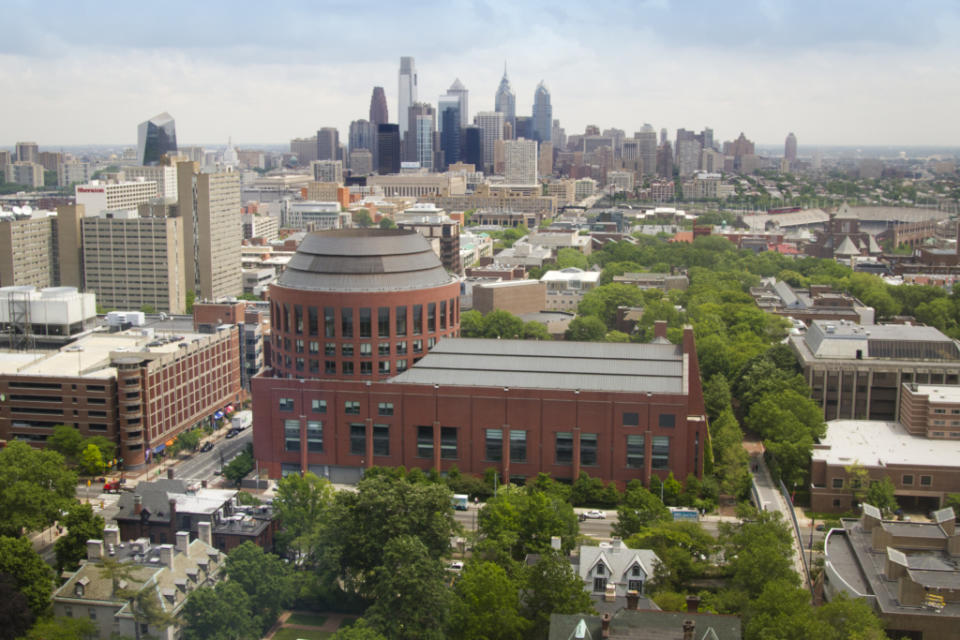Where Fortune 1000 C-Suite Executives Earned Their MBAs

Credit: monkeybusinessimages
“Your network is your net worth.”
“Your alma mater is your identity.”
A business school decision has been equated to everything from one’s brand to one’s destiny. Ultimately, it can impact what you do, where you live, who you know, and which doors open. That begs the question: Does your school choice ultimately define how far you go in your career? Even more, do ‘prestige’ programs place more MBA graduates in the upper echelons of elite companies’ org charts?
To answer these questions, Fortune magazine sicced their education team on the Fortune 1000 firms, parsing the data to see which MBA programs yielded the most CEOs, CFOs, and tech leads (CIOs, CTOs, or CISOs). On Friday, Fortune unveiled some intriguing answers. Does prestige ultimately translate to authority? Turns out, the answer resembles an answer commonly given in most business school courses…
“It depends.”

A Harvard Business School classroom
HARVARD BUSINESS SCHOOL LEADS THE PACK
Let’s begin at the surface level. Yes, top business schools are more highly represented at the top of Fortune 1000 firms. That starts with Harvard Business School, which has placed 94 MBA graduates in CEO, CFO, or CTO-related roles. Not surprisingly, HBS has been described as the “West Point of Capitalism” for its leadership training. This culture has developed leaders ranging from JPMorgan Chase CEO Jamie Dimon to Amazon CEO Andy Jassy. Overall, Harvard Business School alumni make up 7.8% of MBAs with top Fortune 1000 positions according to Fortune. More specifically, HBS is the alma mater of 6% of all Fortune 1000 CEOs according to Fortune.
What is Harvard Business School’s secret? In a 2024 interview with P&Q, Rupal Gadhia, managing director of MBA admissions and financial aid, pointed to its case method. Completing over 500 cases during their two years in Boston, HBS MBAs hone their ability to size up situations, identify uncertainties and tradeoffs, and develop strategies that take into account both short-term demands and long-term opportunities.
“The case method is built on the premise that leaders must make difficult decisions, often with imperfect information,” Gadhia adds. “Each day, our students come to class prepared to listen to their classmates and to present their own ideas, which are core competencies for leaders across any industry. Like business meetings, the classroom is dynamic, fast-paced, and requires active listening. Over the course of two years, students test their ideas and build decision-making skills on real-world problems. This is leadership in action.”

Northwestern Kellogg’s Global Hub Interior
SWEET HOME CHICAGO
Despite Harvard Business School standing out among the c-suite set, Chicago may be the epicenter for graduate business leadership. The University of Chicago’s Booth School and Northwestern University’s Kellogg School each landed 73 MBA graduates on Fortune’s list. Based on Fortune research, 4% of all Fortune 1000 CFOs hold an MBA from the Booth’s School, including Disney CFO Hugh Johnston. That doesn’t count the Microsoft CEO Satya Nadella or Booz Allen Hamilton CEO Horacio Rozanski. Long regaled as the “academic school”, Booth integrates a scientific, evidence-driven method across its programming, with a heavy emphasis on collecting data, interpreting patterns, testing theories, and executing action plans.
“The Chicago Approach is rooted in fundamental scientific disciplines at the heart of business–economics, accounting, psychology, sociology, and statistics—taught by the world-renowned business school faculty,” explains Starr Marcello, Booth’s deputy dean for MBA programs, in a 2023 interview with P&Q. “This provides individuals with an enduring framework; its portability makes it adaptable to any situation, in any industry, and at any time. Our students and alumni say that because of Booth’s unique curriculum–and its focus on analytics and empirical data–they are more prepared than their peers to tackle today’s constantly changing, data-driven business landscape.”
Kellogg’s MBA alumni includes the likes of Expedia Group CEO Ariane Gorin, Intuit CEO Sasan Goodarzi, and Allstate Insurance CEO Thomas Wilson. At Kellogg, leadership is taught through teamwork. Notably, Kellogg administrators estimate that students conduct over 200 meetings during their time in Evanston. In the process, they are exposed to a wide variety of backgrounds, personalities, styles, roles, and ideas – the kinds of experiences that produce versatile leaders comfortable in any setting.
“Kellogg pioneered the team-based learning approach over 40 years ago, enabling students to solve problems by leveraging the diverse viewpoints of their peers,” explains Kate Smith, Kellogg’s former assistant dean of admissions and financial aid who became one of Northwestern’s assistant athletic directors, in a 2020 interview with P&Q. “We believe a difference in perspective, combined with active listening and empathy, can lead to a well-rounded solution. Team-based learning is one Kellogg’s strong suits, and is infiltrated throughout the Kellogg community, and almost every single class offered at Kellogg, especially our experiential courses.”

Washington Olin MBA Students
A MATTER OF QUALITY – OR SIZE?
True to form, the Wharton School ranked 4th among Fortune 1000 MBA c-suite executives with 56 representatives on the list. They were followed by Columbia Business School (39), the University of Michigan’s Ross School (33), Stanford Graduate School of Business (25), New York University’s Stern School (21), and Duke University’s Fuqua School (20).
The list also includes some surprises. Washington University’s Olin School, which only had 83 full-time MBA students in its fall class, boasts 19 c-suite alumni. Vanderbilt University’s Owen School numbered 15 representatives – more than either MIT’s Sloan School or Dartmouth College’s Tuck School (both at 13 students). The University of St. Thomas produced 8 MBA alumni in the Fortune 1000 c-suite, edging out both INSEAD (7) and UC-Berkeley’s Haas School (6).
Maybe the biggest surprise of the Fortune list? It is US-centric, with just the Indian Institute of Management and INSEAD ranked among the Top 50 (though Fortune doesn’t list which IIM had a 1.4% share of MBAs in Fortune 1000 c-suite positions). Another point: An M7 MBA degree isn’t necessarily the ticket to the c-suite according to Fortune. In fact, M7 graduates represent just 31% of CEOs, CFOs and CIO-related positions, with the remaining 69% hailing from programs as divergent as Golden Gate University, the University of Tulsa, Bellevue University, the University of Central Florida, and Syracuse University. In fact, you could say M7 schools enjoy an advantage based strictly on scale. Just look at the size of the most recent incoming classes at these schools: Columbia Business School (1,119), Harvard Business School (938), Wharton School (874), Chicago Booth (637), Northwestern Kellogg (529), Stanford GSB (431), and MIT Sloan (409). These programs rank among the largest full-time MBA student populations, meaning their students will naturally have more cracks at c-suite based on sheer size alone.

Wharton School
GO EAST AND GO PRIVATE
That said, when you expand the MBA graduate population from the M7 to Fortune’s Top 20 programs, the percentage of c-suite representation rises from 31% to 46.3% among the MBA ranks — a sign that name brands pay off. Another advantage, according to Fortune research, is attending a private MBA program. Here, the number of private school MBA graduates in the c-suite doubles their counterparts from private programs. As a whole, MBAs make up either 46% or 48% of the c-suite in the Fortune 1000 (Both numbers are cited in the original Fortune data).
Finally, Fortune reported that the largest concentrations of c-suite MBAs are found in Boston, Chicago, and New York City. It also points to Austin, St. Louis, and Minneapolis as “hubs” for MBA students, while listing Denver, Seattle, and Miami as “lacking” in graduate business education. One reason: neither Denver nor Miami is home to a Top 40 business school. While the University of Washington’s Foster School has placed among America’s 20-best full-time MBA programs in certain rankings, it also housed just 207 students between its first- and second-year classes during the 2023-2024 school year.
That said, the Fortune list comes with two caveats. First, Fortune doesn’t specify whether the Fortune 1000 c-suite MBAs are strictly full-time graduates or includes Executive MBA alumni (or even online MBA graduates in some cases). In some ways, the argument is academic as alumni tend to support their alma mater counterparts regardless of MBA program. What’s more, the list can be considered a lagging indicator, as c-suiters mostly earned their degrees from the 1970s-2010s. Amid curriculum revamps, faculty turnover, and facilities and resources improving over time, it is difficult to discern the degree to which past performance predicts future success among students. In the end, perhaps the choice – and later success – comes down to comfort and fit for students, taking that leap of faith and betting on themselves.
To see the Top 50 MBA programs for Fortune 1000 c-suite representation, go to the next page.
Editor’s Note: Preston Fore, the education staff writer at Fortune who authored the original story, added the following statement regarding Fortune research:
“Our analysis of Fortune 1000 leaders revealed surprising trends in the world of business education. Based on the sheer number of executives without MBAs, it is clear that having the degree is not a precondition to becoming a successful business leader. Also, while those from Harvard Business School or Northwestern’s Kellogg School of Management may be more likely to be a Fortune 1000 leader, the path toward leading a top company is truly malleable.” —Preston Fore, Education Staff Writer, Fortune

The Charles M. Harper Center is the global headquarters of the University of Chicago Booth School of Business, home to our faculty, leadership, and many of our administrative, program, and research center offices.
The designers of the 415,000-square-foot building—completed in 2004—took their inspiration from Frank Lloyd Wright’s world-famous Robie House and the university’s iconic Rockefeller Chapel, each across the street from Booth’s Hyde Park campus.
The post Where Fortune 1000 C-Suite Executives Earned Their MBAs appeared first on Poets&Quants.

